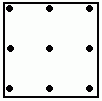|
|
 
Asking the Right Question |
|
|
 
Asking the Right Question |
|
This is the cool part about math: once you ask the right question you often solve the problem! Asking the right question is all about putting your finger on the trickiest part of the problem. Let me show you what I mean. Problem One: Connect Nine Dots
 Here is the problem: connect all nine dots using only four straight lines, and without lifting your pencil off the page. What is the right question?Let's try another one. It is a classic. Problem Two: The Liar ProblemYou're roller-skating down Main Street when two teeny weeny evil math geniuses attack. Before you know it, you're flat on your back, the math geniuses are giggling, and they have your skates. Quick as a flash, the geniuses whip out two trash cans. One genius puts her hand over your eyes. You here some banging, then the hand is removed. Now you can't see your skates. The geniuses hand you a piece of paper. This is what it says:
We are teeny weeny evil math geniuses who like to go around giving people a hard time. We've stolen your skates and put them in one of the two trashcans. We both know which one -- and you don't! Ha! Ha! Here's the deal: you get to ask one of us one question. From the answer you have to decide which can your skates are in. If you're wrong, we get to square your hypotenuse. There's one more little detail. One of us is a compulsive liar. Always lies. Always. To make up for it, the other always tells the truth. To sum up: you can ask one and only one question in order to find out which can your skates are in and get them back. What do you ask? Remember, one of us always lies, one of us always tells the truth. But you don't know which. Ha! Ha! Here is one last problem. Problem Three: Find the False CoinSuppose you have ten bags, each bag has ten coins. You know that a true coin weighs 5 ounces, while a counterfeit coin weighs only 3 ounces. Suppose you have a very accurate bathroom scale. The problem is to find the bag of counterfeit coins, but only using the scale once . I mean it: you only have one opportunity to weigh things. I'm not going to give the full solution to this problem. Try to use the method we developed in the previous problem. If you get stuck, I might give you a hint. Problem solving is all about asking the right question, about knowing how to tackle a problem -- where to attack it. 
|